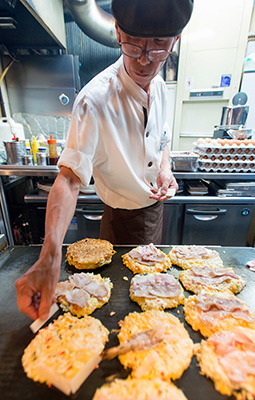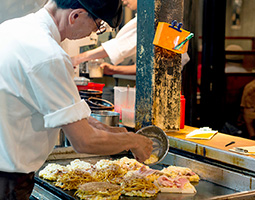Home > Highlighting JAPAN > Highlighting Japan August 2017 > Washoku
Highlighting JAPAN


Happy Food
For the people of Osaka, a night out eating okonomiyaki is a fun event.
The griddle sizzles and hisses as Masanobu Nishikura pours out the dense, lumpy cream-colored mixture, and with two teko steel spatulas fashions his creations into thick, oval cakes.
As each one cooks he flips them over like burgers, then transfers them onto freshly cracked eggs, spinning each one in turn like a DJ whirling discs.
“The trick is to cook them enough, but not too much,” says Nishikura of Osaka-Boteju as he slaps on the pièce de résistance, a viscous brown savory sauce, followed by thin squiggles of mayonnaise and dried bonito flakes, which jig and dance atop the bubbling pancakes, better known as “okonomiyaki.”
Okonomiyaki is to the people of Osaka what masala dosa is to Indians or crêpes are to the French. According to a 2014 government survey, there are 16,551 places nationwide serving okonomiyaki or its close cousin takoyaki (grilled octopus dumplings). Of those, 2,850, or 17.2 percent, are in Osaka — by far the most prevalent in Japan and more than double the number in Tokyo (1,215).
According to Hisao Miyahara, CEO of Osaka-Boteju, which is the oldest okonomiyaki outlet in Osaka, that figure is probably higher. “There’s not a street or alleyway in these parts where you can’t find an okonomiyaki joint and it’s often said there are about 5,000 of them in Osaka alone,” he says. “It’s a deeply ingrained, and loved, part of Osaka’s food culture.”
Okonomiyaki is a relatively new addition to Japanese cuisine, first gaining widespread popularity in the 1950s, when Osaka-Boteju opened its doors.
Its roots, however, date back much further to a dish that was first concocted in a Kyoto teahouse more than 400 years ago.
A simple flour-based crêpe known as funoyaki is thought to be okonomiyaki’s earliest precursor, created, it is said, by sixteenth-century tea guru Sen no Rikyu, who was born in Sakai, present-day Osaka Prefecture, as a cha-gashi snack to accompany green tea.
Over the years, this went through several evolutions, including letter-shaped moji-yaki in the Meiji period (1603–1867) and later on dondon-yaki, a sweet street food and children’s favorite that later was made by dagashi-ya sweetshop owners and served wrapped in a sheet of newspaper, according to Miyahara’s son Yoshio, who is general manager at Osaka-Boteju.
In the Taisho period (1912–1926), green onion-filled issen-yoshoku gained popularity in Kyoto bearing an even closer resemblance to okonomiyaki, not least due to the inclusion of Worcester sauce among its ingredients.
By the 1930s, this had evolved into what is known today as okonomiyaki, or “as you like it, grilled,” a popular item that was also a bit of a luxury item, Yoshio says.
“The main ingredients such as flour and eggs were so expensive you didn’t normally get to eat them unless you were ill,” he explains.
Like dondon-yaki before it, at extra cost, favored toppings could be added, explaining the name it was given, he adds.
Staple ingredients for an Osaka okonomiyaki include flour, eggs, grated naga-imo yam, finely diced cabbage and dashi fish stock for the batter, while the topping includes thin slices of pork belly, squid, octopus, dried bonito flakes, aonori (dried seaweed) and the okonomiyaki sauce, which is like a sweet, viscous version of Worcester sauce that is invariably made from a decades-old family recipe.
“The secret is in the sauce,” says Hisao Miyahara, adding that nonetheless some overseas visitors who are unfamiliar with the custom of splashing sauces on their food tend to forgo that part of the experience.
“A variety of okonomiyaki are made at each individual eatery, and new ingredients, such as cheese and mochi (sticky rice cakes) have been added in recent years. But what distinguished each store was their sauce, which is how they generated their own loyal following.”
Boteju was the first establishment in Osaka to concoct this nourishing dish on a grill right in front of the customer, a tradition that spread far and wide throughout the city and also in other parts of Japan, most notably Hiroshima, where another version of Okonomiyaki garnered widespread popularity.
Fourteen years ago, Miyahara spearheaded a movement to bring Osaka’s okonomiyaki to the attention of a wider audience, in particular to foreign fans of Japanese cuisine, in the process forming an association of okonomiyaki restaurants, which he chairs.
The first event held to celebrate its inauguration was the creation of an 8-meter wide okonomiyaki, concocted on a specially developed grill in the grounds of a local temple. The resulting pancake was big enough to feed 5,000 people.
“One of our objectives is to promote okonomiyaki as ‘happy food,’ not just to Osakans and Japanese but to international visitors as well,” he says. “We Osakans see a night out eating okonomiyaki as a fun event, and we want to nurture that culture.”
© 2009 Cabinet Office, Government of Japan










